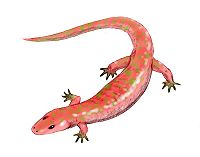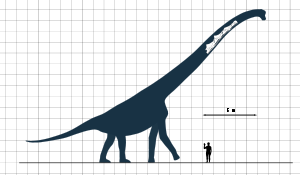
Antlers Formation
Encyclopedia
The Antlers Formation occurs as a band of strata from Arkansas through southern Oklahoma into northeastern Texas. It consists of 150 m of silty to sandy mudstones, fine- to coarse grained sandstones that are poorly to moderately sorted and cemented with clay or calcium carbonate. In places the sandstone may be conglomeratic or ferruginous.
Based on correlation with the Trinity Group of Texas, the Antlers Formation is estimated to be late Aptian-early Albian. This age range is supported by the presence of two dinosaurs that are also known from the Cloverly Formation
, Deinonychus and Tenontosaurus.
Based on correlation with the Trinity Group of Texas, the Antlers Formation is estimated to be late Aptian-early Albian. This age range is supported by the presence of two dinosaurs that are also known from the Cloverly Formation
Cloverly Formation
The Cloverly Formation are Lower Cretaceous strata located in Montana and Wyoming, in the western United States. The term now includes strata that had formerly been called the Dakota Formation in central and southern Wyoming.-Members:...
, Deinonychus and Tenontosaurus.
Amphibians
Indeterminate frog remains. Possible indeterminate salamander remains.| Amphibian Amphibian Amphibians , are a class of vertebrate animals including animals such as toads, frogs, caecilians, and salamanders. They are characterized as non-amniote ectothermic tetrapods... s of the Antlers Formation |
||||||
|---|---|---|---|---|---|---|
| Genus | Species | Location | Stratigraphic position | Abundance | Notes | Images |
Albanerpeton Albanerpeton Albanerpeton is an extinct genus of salamander-like lissamphibian found in North America and Europe. Members of the genus have a robust head and neck which likely allowed them to actively burrow and they lived in a wide range of environments... |
Albanerpeton arthridion |
 |
||||
Basal vertebrates ("Fish")
References: Cifelli et al. 1999; Wedel et al. 2000, Kielan-Jarorowska and Cifelli 2001; Nydam and Cifelli 2002.Cartilaginous fish
| Chondrichthyans of the Antlers Formation | ||||||
|---|---|---|---|---|---|---|
| Genus | Species | Location | Stratigraphic position | Abundance | Notes | Images |
Hybodus Hybodus Hybodus is an extinct genus of once-common, widespread and long lived sharks, first appearing towards the end of the Permian period, and disappearing at the beginning of the Cretaceous. During the Triassic, Jurassic, and Cretaceous periods the hybodonts were especially successful and could be... |
Hybodus buderi |
Hybodontidae |
 |
|||
?Hybodus sp. |
||||||
Lissodus Lissodus Lissodus is an extinct genus of freshwater shark. It lived from the Early Triassic to the Albian period of the Cretaceous. It was about long and had flat teeth that it used for eating clams.... |
Lissodus anitae |
Polyacrodontidae |
||||
Ray-finned fish
Possible indeterminate amiid remains. Possible indeterminate lepisosteid remains. Possible indeterminate semionotidae remains.| Actinopterygians of the Antlers Formation | ||||||
|---|---|---|---|---|---|---|
| Genus | Species | Location | Stratigraphic position | Abundance | Notes | |
Gyronchus Gyronchus Gyronchus is an extinct genus of prehistoric bony fish.-See also:* Prehistoric fish* List of prehistoric bony fish-External links:*... |
Gyronchus dumblei |
|||||
?Palaeobalistum Palaeobalistum Palaeobalistum is an extinct genus of prehistoric bony fish.-See also:* Prehistoric fish* List of prehistoric bony fish-External links:*... |
?Palaeobalistum sp. |
|||||
Mammals
Possible indeterminate deltatheroidan material. Indeterminate multituberculate remains. Indeterminate tribosphenidan remains.| Mammal Mammal Mammals are members of a class of air-breathing vertebrate animals characterised by the possession of endothermy, hair, three middle ear bones, and mammary glands functional in mothers with young... s of the Antlers Formation |
||||||
|---|---|---|---|---|---|---|
| Genus | Species | Location | Stratigraphic position | Abundance | Notes | |
Astroconodon |
Astroconodon sp. |
|||||
Atokatherium |
Atokatherium boreni |
|||||
?Paracimexomys Paracimexomys Paracimexomys is a genus of extinct mammals in the also extinct Multituberculata order. Paracimexomys lived during the Cretaceous period. The few fossils remains come from North America. Some Romanian fossils were also tentatively assigned to this genus, though that classification now seems... |
Paracimexomys crossi |
|||||
Crurotarsans
Possible indeterminate atoposaurid remains. Possible indeterminate goniopholidid remains. Possible indeterminate pholidosaurid remains.| Crurotarsans of the Antlers Formation | ||||||
|---|---|---|---|---|---|---|
| Genus | Species | Location | Stratigraphic position | Abundance | Notes | |
Bemissartia |
Bemissartia sp. |
|||||
Lepidosaurs
Possible indetrminate scincid remains.| Lepidosaurs of the Antlers Formation | ||||||
|---|---|---|---|---|---|---|
| Genus | Species | Location | Stratigraphic position | Abundance | Notes | |
Atokasaurus |
Atokasaurus metarsiodon |
|||||
Bemissartia |
Bemissartia sp. |
|||||
Ptilotodon |
Ptilotodon wilsoni |
|||||
Ornithischia
| Ornithischians of the Antlers Formation | ||||||
|---|---|---|---|---|---|---|
| Genus | Species | Location | Stratigraphic position | Abundance | Notes | Images |
Tenontosaurus Tenontosaurus Tenontosaurus is a genus of medium- to large-sized ornithopod dinosaur. The genus is known from the late Aptian to Albian ages of the middle Cretaceous period sediments of western North America, dating between 115 to 108 million years ago... |
Tenontosaurus sp. |
 |
||||
Saurischians
Possible indeterminate bird remains are known from the formation.| Saurischians of the Antlers Formation | ||||||
|---|---|---|---|---|---|---|
| Genus | Species | Location | Stratigraphic position | Material | Notes | Images |
Acrocanthosaurus Acrocanthosaurus Acrocanthosaurus is a genus of theropod dinosaur that existed in what is now North America during the Aptian and early Albian stages of the Early Cretaceous. Like most dinosaur genera, Acrocanthosaurus contains only a single species, A. atokensis. Its fossil remains are found mainly in the U.S... |
Acrocanthosaurus atokensis |
 |
||||
Astrodon Astrodon Astrodon was a genus of large herbivorous sauropod dinosaur, related to Brachiosaurus, that lived in what is now the eastern United States during the Early Cretaceous period. Its fossils have been found in the Arundel Formation, which has been dated through palynomorphs to the Aptian-Albian... |
Astrodon sp. |
|||||
Deinonychus Deinonychus Deinonychus was a genus of carnivorous dromaeosaurid dinosaur. There is one described species, Deinonychus antirrhopus. This 3.4 meter long dinosaur lived during the early Cretaceous Period, about 115–108 million years ago . Fossils have been recovered from the U.S... |
Deinonychus sp. |
|||||
Sauroposeidon Sauroposeidon Sauroposeidon is a genus of sauropod dinosaur known from four neck vertebrae that were found in the southeastern portion of the US state of Oklahoma. The fossils were found in rocks dating to the Early Cretaceous, a period when the sauropods of North America had diminished in both size and... |
Sauroposeidon proteles |
"[Four] cervical vertebrae." |
||||
Turtles
| Turtle Turtle Turtles are reptiles of the order Testudines , characterised by a special bony or cartilaginous shell developed from their ribs that acts as a shield... s of the Antlers Formation |
||||||
|---|---|---|---|---|---|---|
| Genus | Species | Location | Stratigraphic position | Abundance | Notes | |
?Glyptops Glyptops Glyptops is an extinct genus of cryptodire turtle dating from the Late Jurassic and Early Cretaceous periods 155 to 99 m.y.a. Fossils have been found in South Dakota, Wyoming, Colorado, Utah, New Mexico, Oklahoma, and Texas from both the Morrison and Cedar Mountain formations. The type species is G... |
Glyptops sp. |
|||||
Naomichelys |
Naomichelys sp. |
|||||

